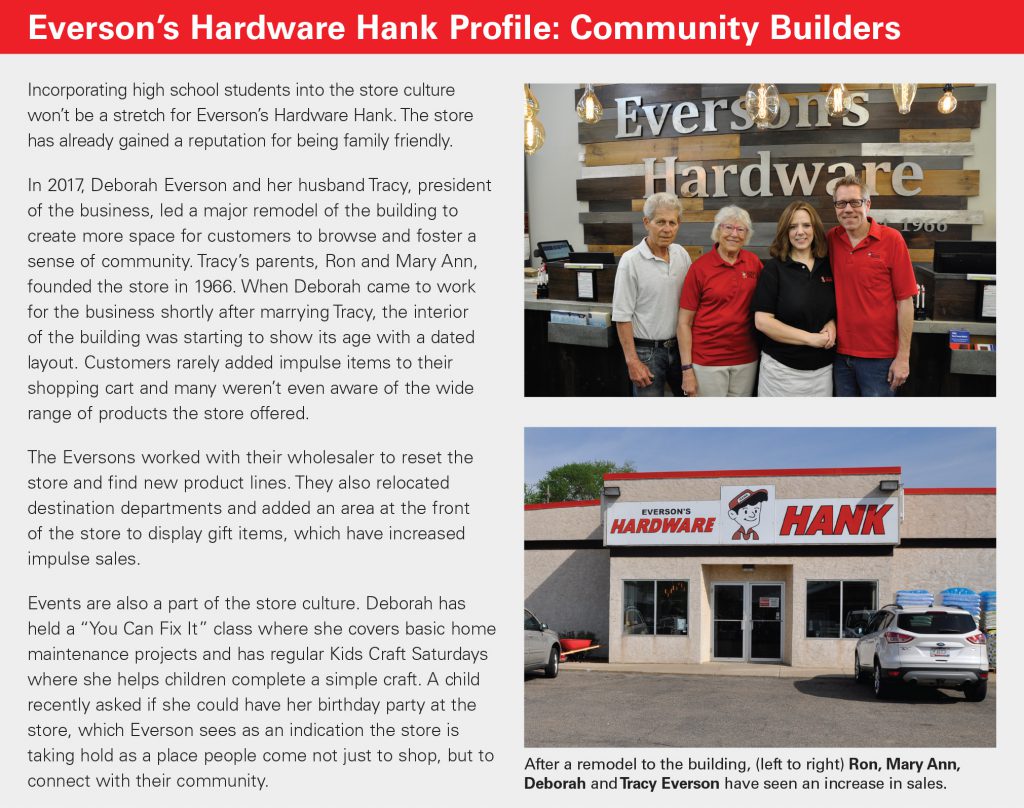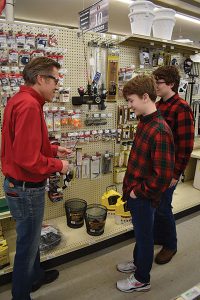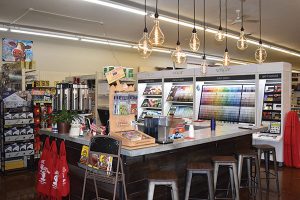By Jesse Carleton, jcarleton@nrha.org
Back to School
How can home improvement stores appeal to the next generation of shoppers? That was the topic of discussion at Everson’s Hardware Hank, in Waconia, Minnesota, on a Monday morning in February. Five students from Waconia High School had spent the past few weeks studying multiple aspects of the business and coming up with their own recommendations for how to answer that question. Now it was time to share the results with the company’s marketing manager, Deborah Everson.
Everson was participating in a group project with an entrepreneurship class where students were asked to help her learn more about what the teenage demographic wanted out of a home improvement store. It was educational for all involved. Students learned about running a business and the principles of leadership, while Everson found some insights into how she could reach out to the next generation of home improvement shoppers.
To hear those recommendations firsthand, Hardware Retailing traveled to Everson’s Hardware to see the students’ presentation and then hear what Everson learned from the exercise. Building connections with your local high school can not only offer an avenue for giving back to your community, but also it can give you insights into an increasingly important customer segment.

The Project: Finding the Next Generation
Like many retailers who want to be involved in their local communities, Everson is a member of her local Chamber of Commerce. That’s where she met a consultant working at Waconia High School and learned about the project. The class, “Start Your Own Business,” is designed to help students learn about entrepreneurship. Some students who take the class are exploring business as a future career. Some of the students had already taken other business classes, so they were building on past knowledge.
This year, instead of merely teaching from a book, class instructors wanted students to gain hands-on experience. The class was divided into seven groups and assigned to different independent businesses around town. Each of those businesses’ owners wanted help conducting market research. For example, the local grocery store operator wanted to know what grab-and-go food items to add to their deli. The performing arts center staff wanted to know what events people in the community would find appealing and at what price point.
“We wanted to know what products, services or events would appeal to 16- to 25-year-olds,” says Everson. Typical of most retailers, Everson’s customers are mostly between 30 and 60, the age range most likely to be shopping at a home improvement store. But the younger age group will be future customers, so Everson wants to have a role in influencing their shopping patterns.
For the five students assigned to her store, Everson was able to act as a business mentor as she gave them a close-up look at how her business operated. The students came to the store several times throughout the course to discuss the project and get direction from Everson. She was also a guest speaker for the class, sharing her thoughts on what it takes to be a business leader.
At the heart of the project was a five-question survey the students sent via Google Forms to their fellow classmates to see what products, services or events might encourage them to shop at their local hardware store. When the results were in, the students were tasked with coming up with their own recommendations for Everson’s.
The Results: Hosting How-To Seminars
Classes or special events that demonstrated how to do a particular project were the focus of the students’ recommendation to Everson. This was their proposal: “Create a set of handmade product classes where people will come in and make a project from the materials provided by Hardware Hank and be taught how to create the project for an affordable price.”
While some product categories, such as sporting goods, got the students interested in shopping at Everson’s, a good strategy for attracting the younger generation was hosting “make-and-take” project classes.
Everson’s Hardware Hank already offers project classes, but none target the 16- to 25-year-old age group. The students suggested the store could charge a fee to attend the class ($40 on average was their suggestion, based on the average cost of materials and profit for the store).
“Any money I have to pay would be worth the education,” says Griffen Jensen, a student who was in charge of communication for the group. “I would be learning a lot about the items we would be using, then I get to take the project home. I’m getting a lot more than just buying something off the shelf.”
Examples of projects the students cited included a lamp made out of black iron pipe or a simple toolbox. The students also noted that the big-box home improvement stores in the area offered only limited project classes, with little variety in the products offered, and none of them targeted their age group. To market the how-to seminars, the students recommended putting short videos on Instagram—the social media platform most of them already used.
The Next Steps: Communicating More
While the students’ work on the project may be finished, Everson is ready to try some of their ideas.
“It was fun to hear what they learned about our store through the survey results,” she says. “I’m anticipating implementing some of the recommendations they had for the classes. I think there are ways we can gear our business to appeal more to the 16-year-old-and-up age group.”

Make-and-Take Classes
One of the biggest takeaways from the students’ project was that project classes, or make-and-take classes, could have potential for drawing in the younger generation. Classes are already a part of the store’s culture. Everson runs Kids Craft Saturdays, a popular series of events targeted at children. She’s also held classes for adults, showing how to make common home improvement repairs. But the missing piece so far has been an event for high school and college-age young adults.
Everson says she’s already been looking at Pinterest to gather project ideas. But the value in the classes isn’t just about bringing students into the store; it will also be about bringing friends and families together. Students expressed interest in classes that could involve their friends or parents.
“A big goal is to facilitate ways to get kids and their parents engaged together,” she says. “If we can find ways to bring families together, that’s what will set us apart as independents and create that family atmosphere in our store.”
Encouraging students to engage in simple projects will also give them more confidence in their DIY abilities. The younger generation too often makes big-box retailers their first choice, she observes, but she hopes that by attracting them to her store early, she can change that mindset.
“When these teenagers grow up and purchase their first home, I want them to first think of their local hardware store instead of going to the big-box store,” she says. “It’s important we think about how we can influence the younger generation and help them have positive experiences in our store. That is what will help us as an industry thrive into the future.”
Instagram
Everson also had the opportunity to listen to the other student groups working with businesses around town. The common thread through all of the group discussions was the need for businesses to use Instagram as their preferred social media to communicate with the younger generation.
While Everson’s has a Facebook page, few of the students in the group knew about it. They all have Facebook accounts, but they rarely use them. Instead, Instagram was the teens’ preferred social media platform. It’s a good place to share project ideas. But if you’re going to post a video, make sure they are short, more like a time-lapse video, just long enough for the viewer to see how a project goes together. Teens use YouTube to watch longer, in-depth project videos.
In fact, Everson’s makes a few posts on Instagram, but none of the students were aware of the account. They made some suggestions for ways to change that. For example, there is a local vocal artist who does a lot of work with the high school’s music program. Many students follow her Instagram page. Students suggested Everson incorporate that vocalist, or a similar local figure, into the store’s marketing strategy. They would be more likely to see the store’s post if it was connected with the celebrity’s post. Also, using hashtags with the city or school name in it is an effective way of getting followers on Instagram.

Connect With Schools
Retailers who want to connect with high school students don’t necessarily have to be a mentor for a business class. There are many avenues for creating connections with students and their families, says Everson. “For me, it started with being involved in the Chamber of Commerce, where I made a connection with someone from the school,” she says.
You can also go directly to the school and communicate your desire to help where you can. There are many ways to engage students through groups such as robotics clubs, science groups, theater, industrial arts classes, trap shooting teams or business classes, just to name a few.
“These groups target specific groups of students who may use items we sell, which is an opportunity to help us build positive working relationships with them,” Everson says. “It’s the relationships we build with students that will help us attract the next generation to shop at their local independent hardware stores.”
The exercise with the group of five students has already yielded progress toward Everson’s goal. They said they were starting to see the attraction of independent retailers such as Everson’s.
“When I go to Home Depot, for example, I don’t see someone unless I need help, and then I have to find someone,” says Sam Schmidt, another student in the class. “At Hardware Hank, I can get the help right away and am not stranded not knowing what to do. I think before, we saw this store just as a place to come in, get what we needed and get out. Now, I’m seeing people come in, say hi, grab a cup of coffee then go get their product. A lot of people seem to know everyone at this store pretty well. I’m seeing people come in for more of an experience.”
Click here to download a PDF of this story.
 Hardware Retailing The Industry's Source for Insights and Information
Hardware Retailing The Industry's Source for Insights and Information








